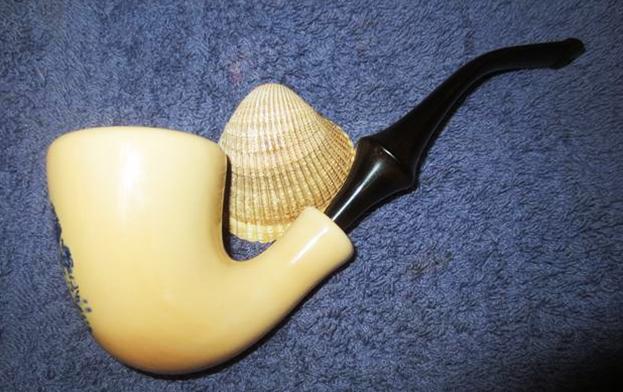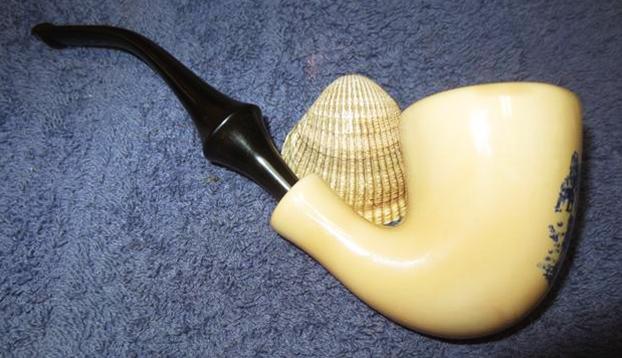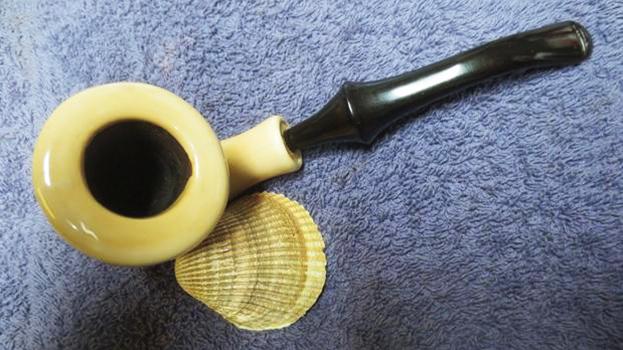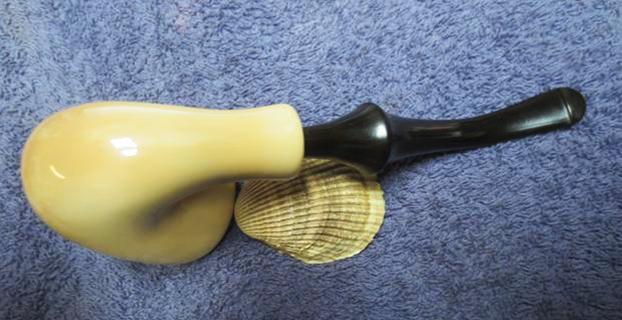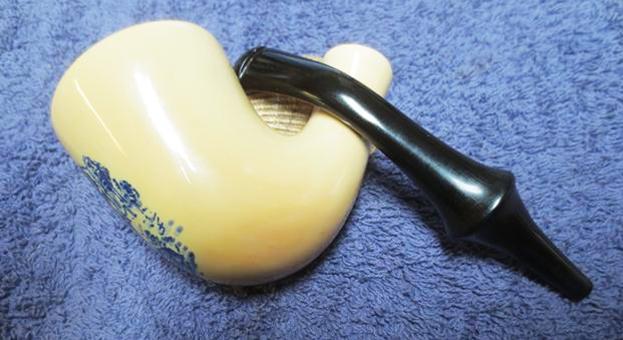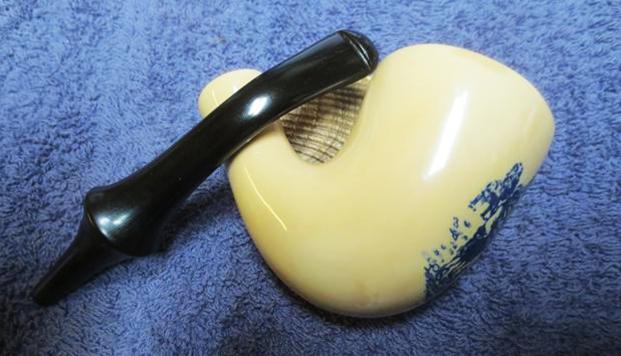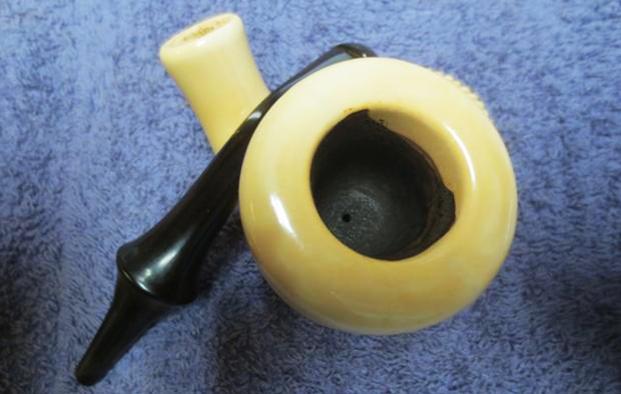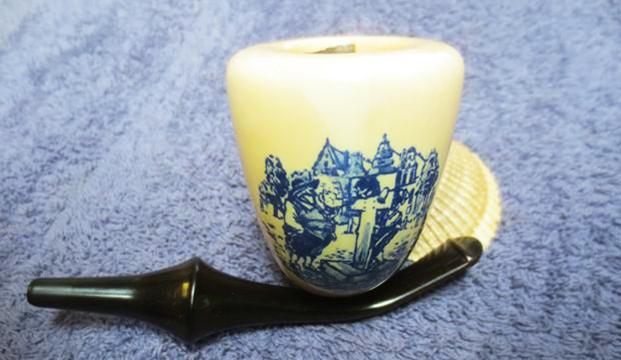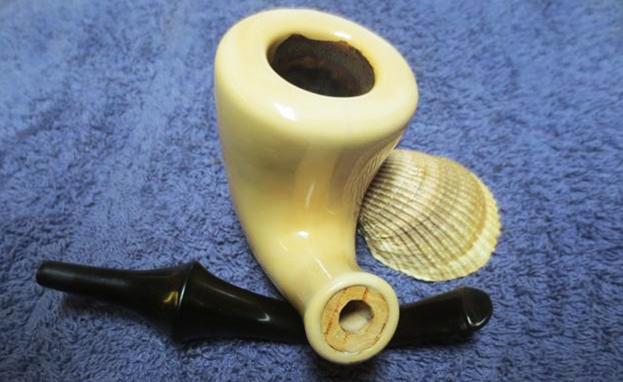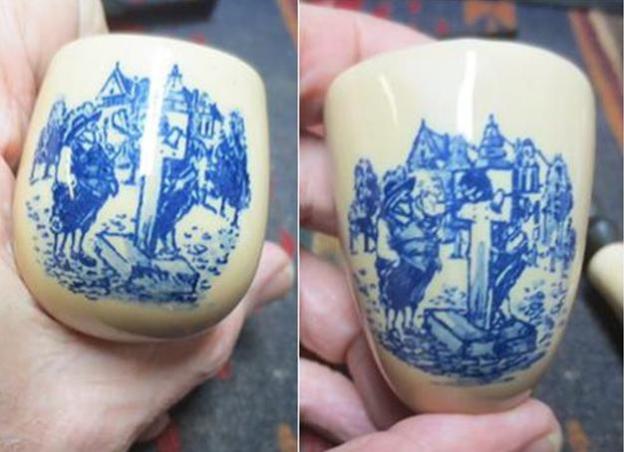Blog by Steve Laug
This pair of double walled ceramic pipes was originally white with a blue Delft style scene painted and cured into the ceramic on the front of both bowls. They both have a painting of a scene that is a famous picture from Troost Tobacco where one man is in the stocks and another, rather portly man is helping him smoke a pipe. There is no other stamping on either pipe. Both pipes have begun to develop a nice patina as the bowls darken from smoking them. The stem on the smaller of the two (photos 1-4) was a typical freehand stem like many I have seen and used in the past. The one on the larger calabash (photos 5-8) shaped one is like the stems on WDC Wellington’s – kind of a faux p-lip with the airway coming out the end of the button rather on the top like a Peterson. The smaller pipe had a rubber stopper in the end of the shank to hold the stem in place and the larger one had a crumbling cork stopper. Both pipes were very dirty with cake in the bowls and oxidation on the stem surfaces. 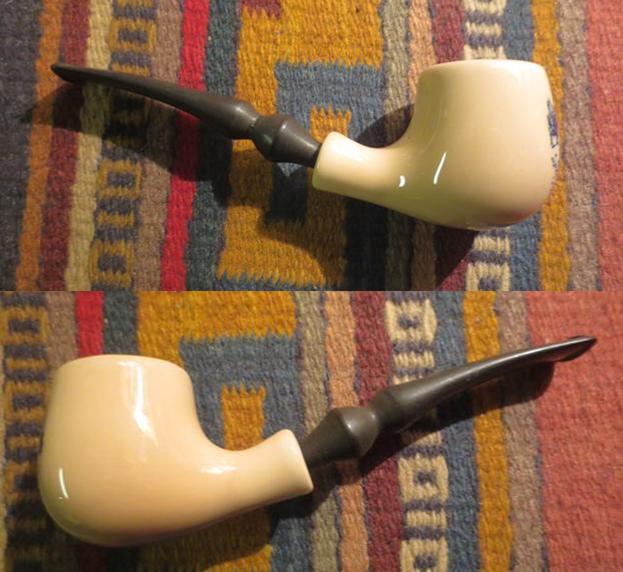
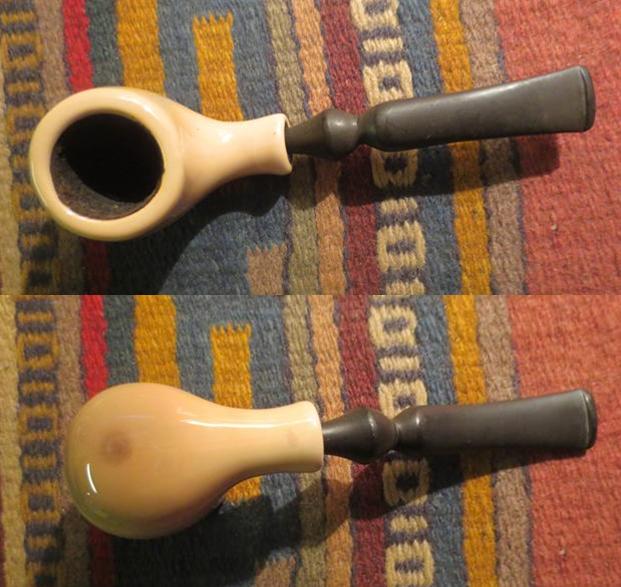
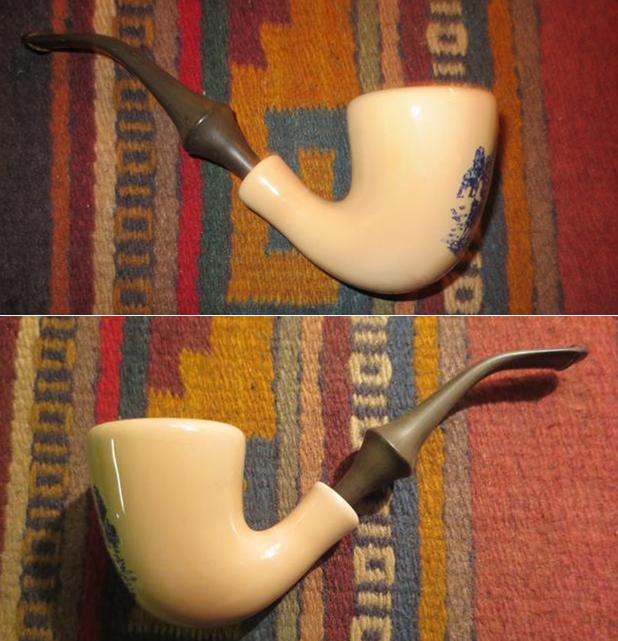
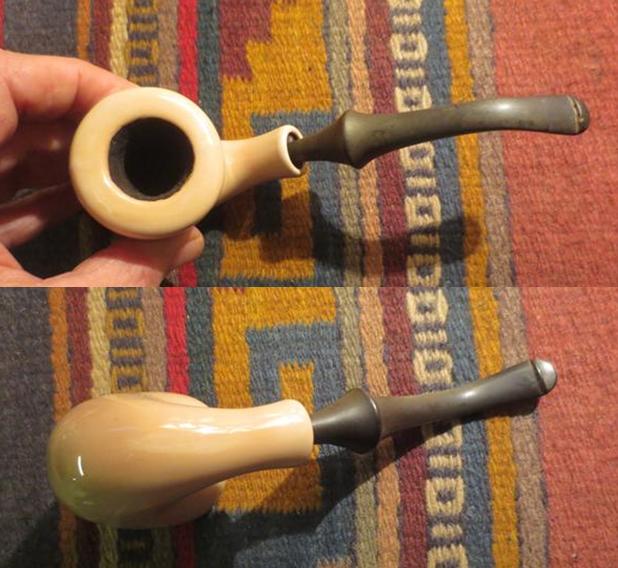 The pipes were made by an old Dutch pipe making house called Goedewaagen. Here is the link to their website. Have a look at the history page on the site. It gives a detailed background on the Company that made the pipes. Even though the link is in Dutch it is worth translating with Google Translate. http://www.goedewaagen.nl/goedewaagen/. I have included the cutaway diagram of the double walled ceramic pipe to help give and idea of the concept and construction of the pipe.
The pipes were made by an old Dutch pipe making house called Goedewaagen. Here is the link to their website. Have a look at the history page on the site. It gives a detailed background on the Company that made the pipes. Even though the link is in Dutch it is worth translating with Google Translate. http://www.goedewaagen.nl/goedewaagen/. I have included the cutaway diagram of the double walled ceramic pipe to help give and idea of the concept and construction of the pipe. Both pipes came to me from the estate of a Vancouver pipe smoker whose widow left them with RJ Clarke’s Pipe Shop after he died. I was asked to clean them up and sell them for the shop as it has since closed. I decided to work on them together as they will need the same kind of cleanup and restoration. The photos below show both pipes as they were when I brought them to my work table.
Both pipes came to me from the estate of a Vancouver pipe smoker whose widow left them with RJ Clarke’s Pipe Shop after he died. I was asked to clean them up and sell them for the shop as it has since closed. I decided to work on them together as they will need the same kind of cleanup and restoration. The photos below show both pipes as they were when I brought them to my work table.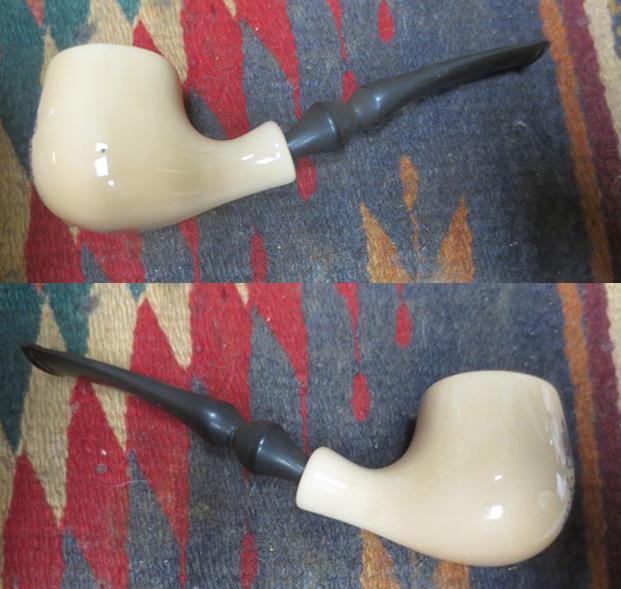
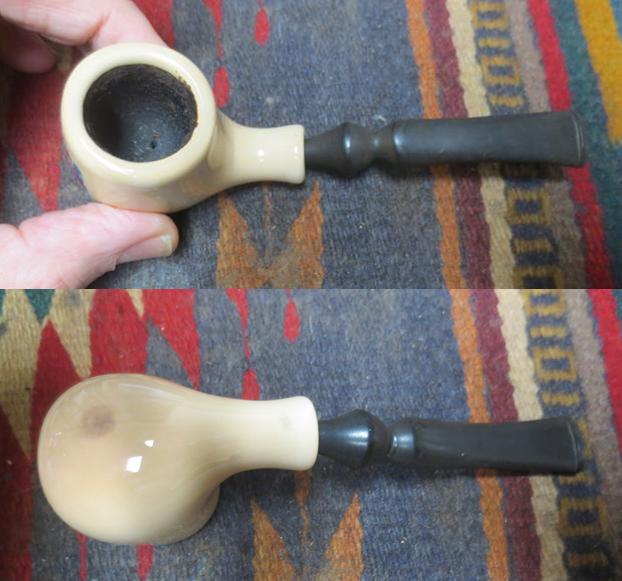
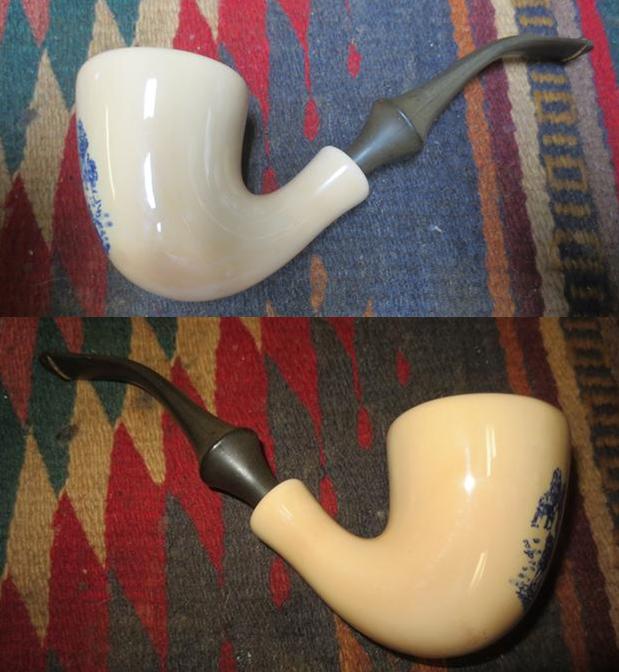
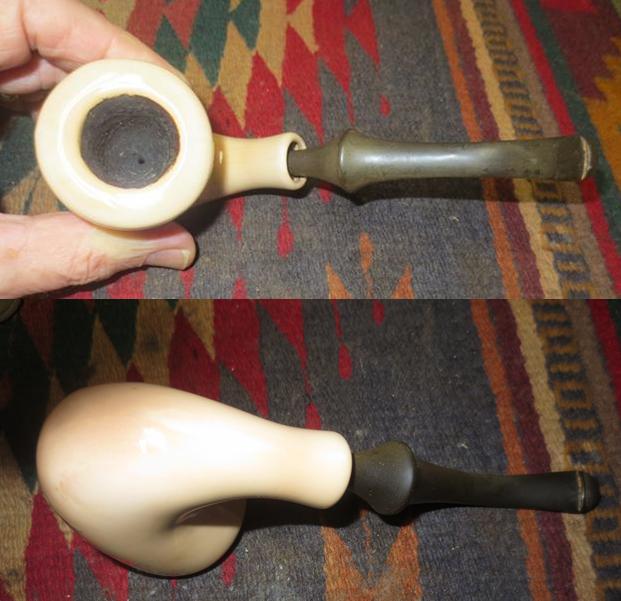 I took photos of each of the bowls to show the cake lining the walls and the condition of the bowl and rim top. Both had a thick cake and the airway at the bottom of both bowls was half plugged making the airflow quite restricted.
I took photos of each of the bowls to show the cake lining the walls and the condition of the bowl and rim top. Both had a thick cake and the airway at the bottom of both bowls was half plugged making the airflow quite restricted.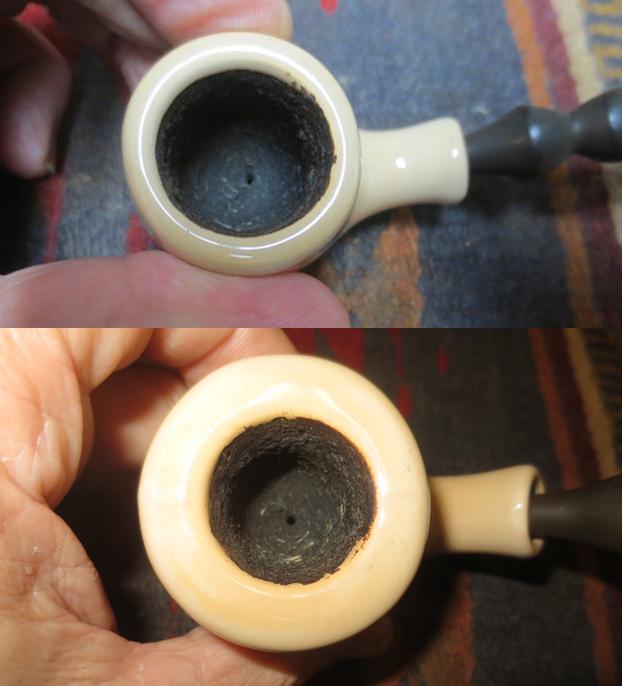 The paintings on both bowls were identical – a painting of a scene that is a famous picture from Troost Tobacco where one man is in the stocks and another, rather portly man is helping him smoke a pipe.
The paintings on both bowls were identical – a painting of a scene that is a famous picture from Troost Tobacco where one man is in the stocks and another, rather portly man is helping him smoke a pipe.  As mentioned above both shanks used a stopper in the mortise to hold the stem in place. The smaller pipe used a rubber stopper and the calabash style pipe had a cork stopper. The rubber one was in good condition while the cork one was crumbling and pushed into the mortise. The photos below show the two stoppers.
As mentioned above both shanks used a stopper in the mortise to hold the stem in place. The smaller pipe used a rubber stopper and the calabash style pipe had a cork stopper. The rubber one was in good condition while the cork one was crumbling and pushed into the mortise. The photos below show the two stoppers.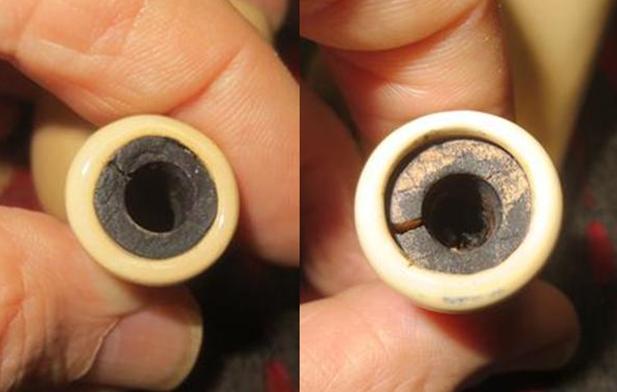 The stems were quite different in terms of condition. It appeared to me that the one on the smaller pipe was better quality vulcanite than the other one and it was barely oxidized. There was light tooth chatter on the stem. The stem on the calabash pipe was heavily oxidized and the tooth chatter and marks were heavier.
The stems were quite different in terms of condition. It appeared to me that the one on the smaller pipe was better quality vulcanite than the other one and it was barely oxidized. There was light tooth chatter on the stem. The stem on the calabash pipe was heavily oxidized and the tooth chatter and marks were heavier.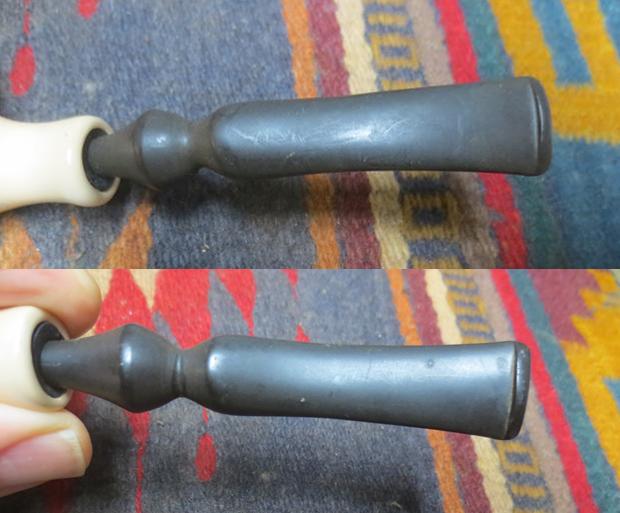
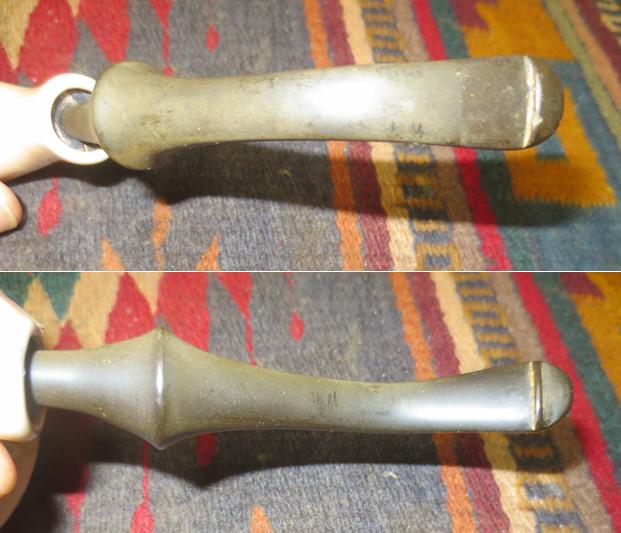 I put both stems in the Before & After Pipe Stem Deoxidizer bath to soak overnight. I knew that it would work well on the stem from the smaller pipe as it was less oxidized. The heavier oxidation on the calabash stem would be harder because the bath was getting less effective after soaking and cleaning 80-90 stems in it.
I put both stems in the Before & After Pipe Stem Deoxidizer bath to soak overnight. I knew that it would work well on the stem from the smaller pipe as it was less oxidized. The heavier oxidation on the calabash stem would be harder because the bath was getting less effective after soaking and cleaning 80-90 stems in it.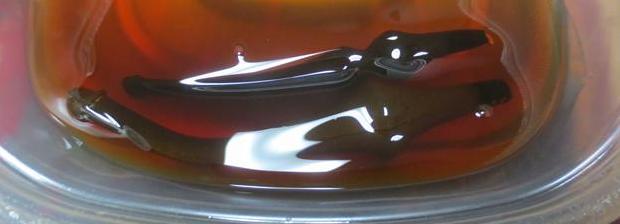 I scraped out the cake in both bowls using the Savinelli Fitsall Pipe Knife. I removed all of the cake and sanded the inside of the bowls with 220 grit sandpaper to remove the remnants. I used a dental pick to clean out the clogged airway at the bottom of each bowl.
I scraped out the cake in both bowls using the Savinelli Fitsall Pipe Knife. I removed all of the cake and sanded the inside of the bowls with 220 grit sandpaper to remove the remnants. I used a dental pick to clean out the clogged airway at the bottom of each bowl.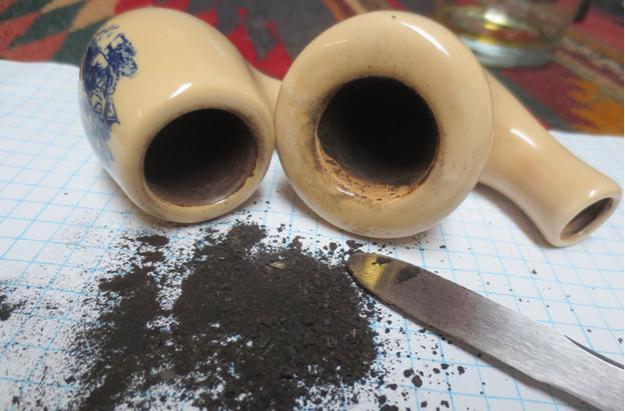 The rubber stopper on the smaller pipe was in good condition and still usable. The cork stopper was crumbling and I could hear pieces rattling in between the double walls of the ceramic pipe. I used a pen knife to clean out the pieces of cork.
The rubber stopper on the smaller pipe was in good condition and still usable. The cork stopper was crumbling and I could hear pieces rattling in between the double walls of the ceramic pipe. I used a pen knife to clean out the pieces of cork. 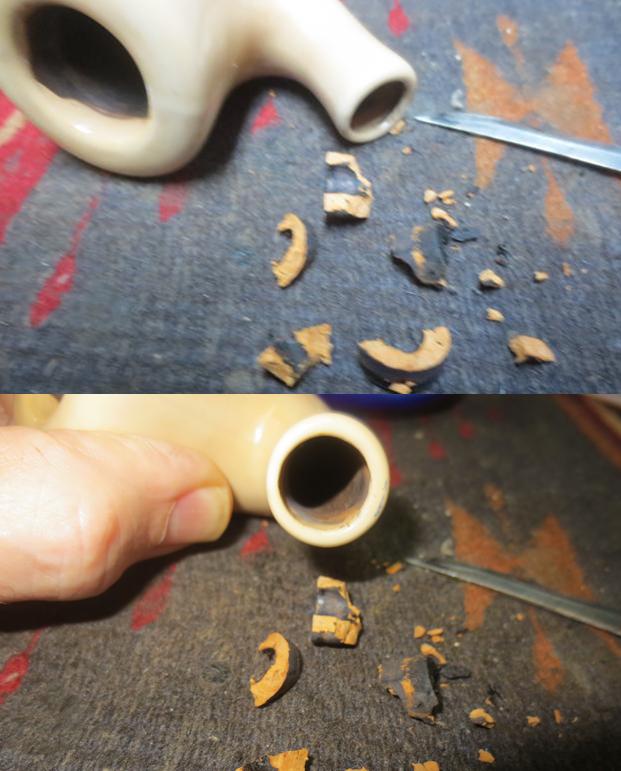 I cleaned both bowls under warm running water. I filled the space between the two walls of both pipe with hot water and shook it to loosen any residual tars or oils that had collected in those spots. I shook the water out and repeated the cleaning until the shanks and insides of both pipes were clean. I scrubbed the outside of the bowl and the inside of the bowl with hot water and a light detergent to remove the dirt on the glazed ceramic finish. While I was cleaning the bowls I remembered that I had inherited a bag of corks that were drilled or Le Peltier ceramic pipes. I took one out and was glad that it was the proper diameter for the calabash.
I cleaned both bowls under warm running water. I filled the space between the two walls of both pipe with hot water and shook it to loosen any residual tars or oils that had collected in those spots. I shook the water out and repeated the cleaning until the shanks and insides of both pipes were clean. I scrubbed the outside of the bowl and the inside of the bowl with hot water and a light detergent to remove the dirt on the glazed ceramic finish. While I was cleaning the bowls I remembered that I had inherited a bag of corks that were drilled or Le Peltier ceramic pipes. I took one out and was glad that it was the proper diameter for the calabash. 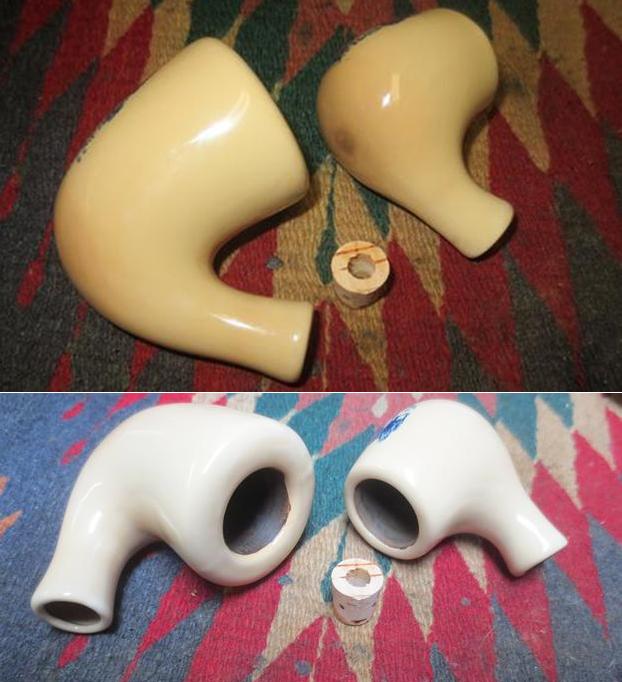 I dried out the shank and the bowl with paper towels and wetted the cork to cause it to swell. The fit in the mortise was perfect. I used a dental pick to carefully lift it out of the mortise and coated it with all-purpose glue. I pressed it in to the mortise until the surface of the end of the cork was the same distance from the outer edges as the rubber stopper on the other pipe. I set the bowl aside to let the glue dry before trying the stem on the pipe. I took photos of both bowls to show how clean they were at this point in the process.
I dried out the shank and the bowl with paper towels and wetted the cork to cause it to swell. The fit in the mortise was perfect. I used a dental pick to carefully lift it out of the mortise and coated it with all-purpose glue. I pressed it in to the mortise until the surface of the end of the cork was the same distance from the outer edges as the rubber stopper on the other pipe. I set the bowl aside to let the glue dry before trying the stem on the pipe. I took photos of both bowls to show how clean they were at this point in the process. 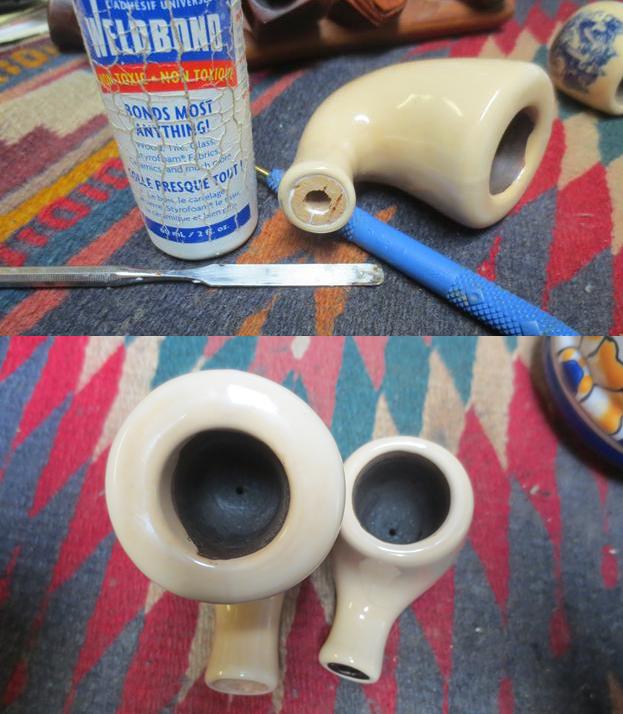

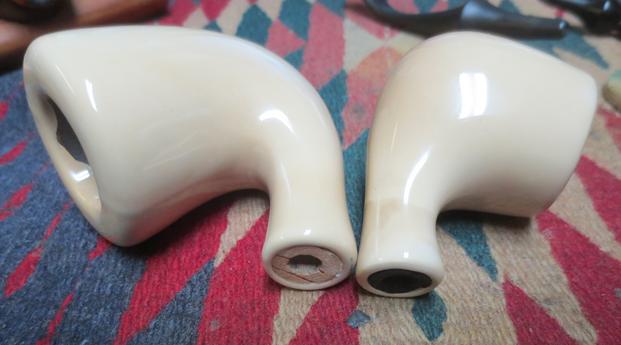 By this time the stems had been soaking since the night before. I took them out of the bath and held them over the container to let the thick solution drip clean of the stems. When the majority had dripped clean I dried them off with a rough cotton cloth the wipe off as much of the oxidation on the rubber as possible in the drying process. I cleaned the airway on both stems with alcohol and pipe cleaners until the deoxidizer and the tars and oils in the stems was removed and they were clean. In retrospect I should have cleaned them before soaking them but hindsight is always better anyway. The stem with the lighter oxidation came out almost perfect. The other one was certainly better than before the soak.
By this time the stems had been soaking since the night before. I took them out of the bath and held them over the container to let the thick solution drip clean of the stems. When the majority had dripped clean I dried them off with a rough cotton cloth the wipe off as much of the oxidation on the rubber as possible in the drying process. I cleaned the airway on both stems with alcohol and pipe cleaners until the deoxidizer and the tars and oils in the stems was removed and they were clean. In retrospect I should have cleaned them before soaking them but hindsight is always better anyway. The stem with the lighter oxidation came out almost perfect. The other one was certainly better than before the soak.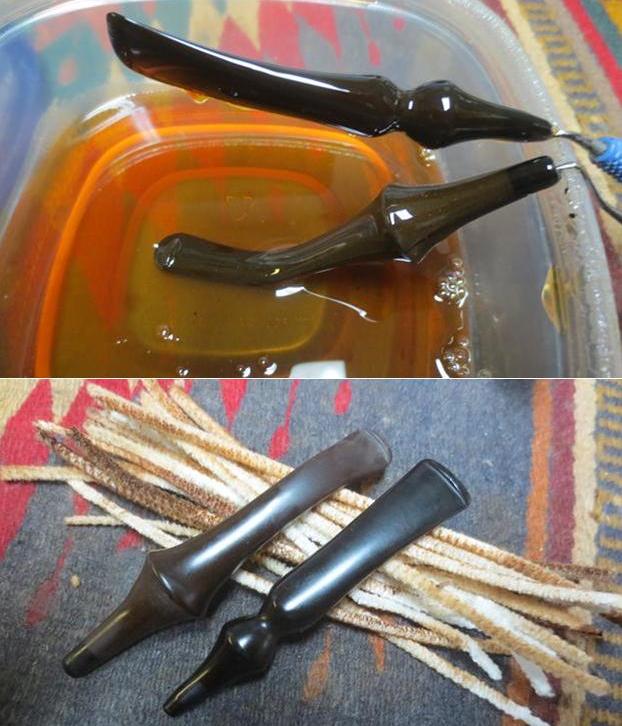 The stems looked good but more work would need to be done before the final black gleam was back. I buffed both stems with red Tripoli to remove the remaining oxidation. I sanded both stems with 220 grit sandpaper to remove the tooth chatter from both sides near the button. I did more work on the stem from the calabash to remove the heavier oxidation of the vulcanite and to reshape the button. Once I was finished with the sanding I buffed both stems again with the red Tripoli. After buffing them I polished them with micromesh sanding pads – wet sanding them with 1500-2400 grit pads and wiping them down after each pad with Obsidian Oil to give the next pad more bite when I sanded. I dry sanded them with 3200-12000 grit pads and again wiped them down with the oil after each pad. After the final pad I wiped them down a final time with the oil and set them aside to dry.
The stems looked good but more work would need to be done before the final black gleam was back. I buffed both stems with red Tripoli to remove the remaining oxidation. I sanded both stems with 220 grit sandpaper to remove the tooth chatter from both sides near the button. I did more work on the stem from the calabash to remove the heavier oxidation of the vulcanite and to reshape the button. Once I was finished with the sanding I buffed both stems again with the red Tripoli. After buffing them I polished them with micromesh sanding pads – wet sanding them with 1500-2400 grit pads and wiping them down after each pad with Obsidian Oil to give the next pad more bite when I sanded. I dry sanded them with 3200-12000 grit pads and again wiped them down with the oil after each pad. After the final pad I wiped them down a final time with the oil and set them aside to dry.
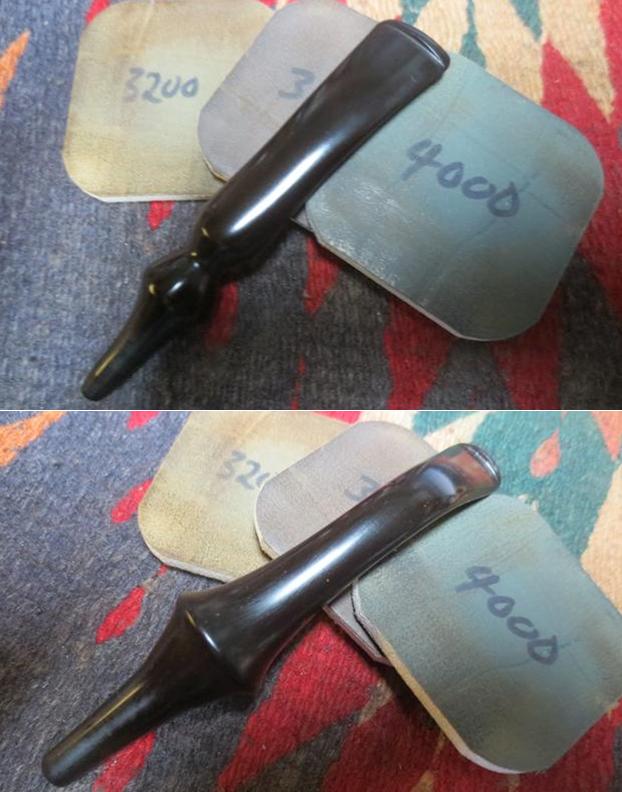
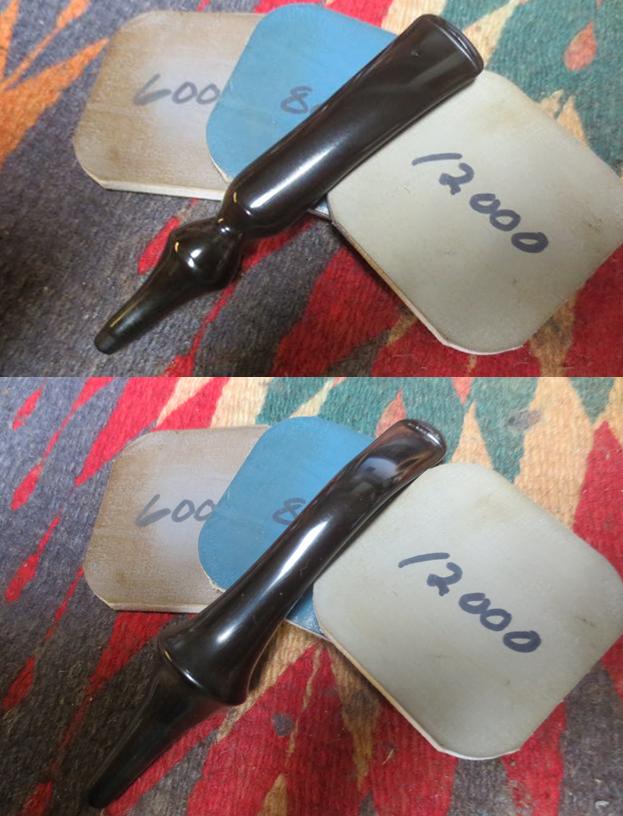 I put the stem back on the bowl and buffed the entire pipe with Blue Diamond on the buffing wheel to polish the stem and the bowl. I used a soft touch on the bowl as I did not want to damage the paintings on the bowl fronts of the ceramic polish in any way. I buffed stem hard to work over the remaining small scratches and minute oxidation that was still on the rubber of both stems. It took some work but they cleaned up nicely. I gave the bowls and the stems multiple coats of carnauba wax buffed them with a clean buffing pad to raise a shine. I hand buffed the pipes with a microfiber cloth to deepen the shine. The two double walled bowls with the Delft style painting on the front and the developing brown patina combined with the black vulcanite stems present a beautiful pair of pipes. I find these interesting double walled Goudewaagen ceramic pipes a pleasant change to the briar pipes that I normally work on. The finished pipes are shown in the photos below. The dimensions of the smaller brandy shaped pipe are Length: 6 inches, Height: 1 ¾ inches, Bowl diameter: 1 ½ inches, Chamber diameter: 7/8 inches.
I put the stem back on the bowl and buffed the entire pipe with Blue Diamond on the buffing wheel to polish the stem and the bowl. I used a soft touch on the bowl as I did not want to damage the paintings on the bowl fronts of the ceramic polish in any way. I buffed stem hard to work over the remaining small scratches and minute oxidation that was still on the rubber of both stems. It took some work but they cleaned up nicely. I gave the bowls and the stems multiple coats of carnauba wax buffed them with a clean buffing pad to raise a shine. I hand buffed the pipes with a microfiber cloth to deepen the shine. The two double walled bowls with the Delft style painting on the front and the developing brown patina combined with the black vulcanite stems present a beautiful pair of pipes. I find these interesting double walled Goudewaagen ceramic pipes a pleasant change to the briar pipes that I normally work on. The finished pipes are shown in the photos below. The dimensions of the smaller brandy shaped pipe are Length: 6 inches, Height: 1 ¾ inches, Bowl diameter: 1 ½ inches, Chamber diameter: 7/8 inches. 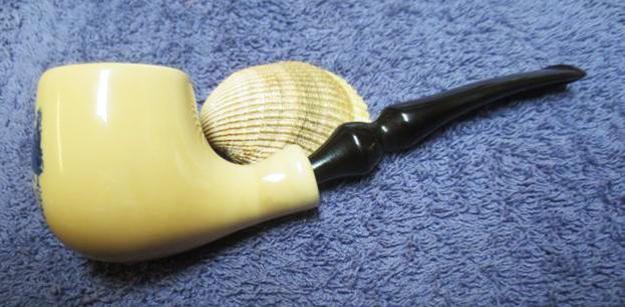
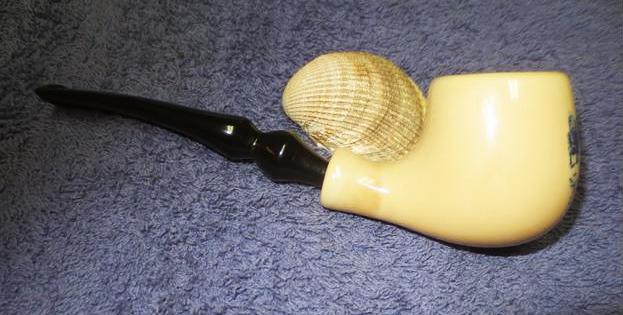
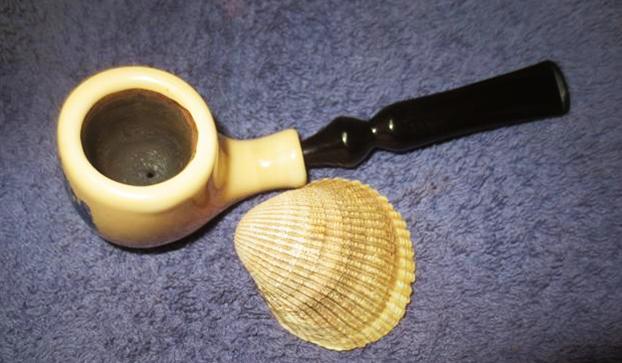
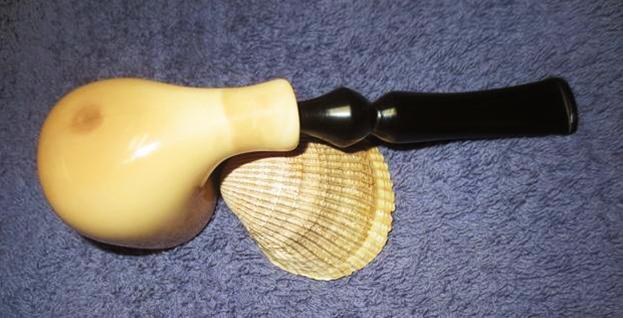
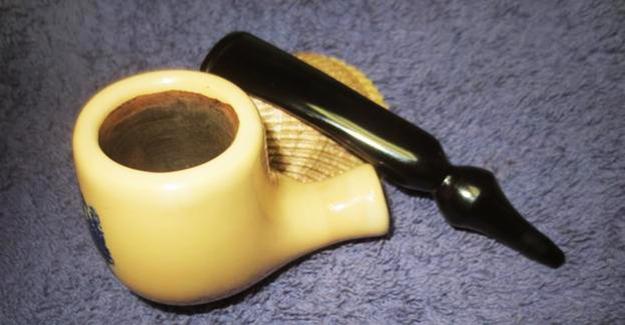
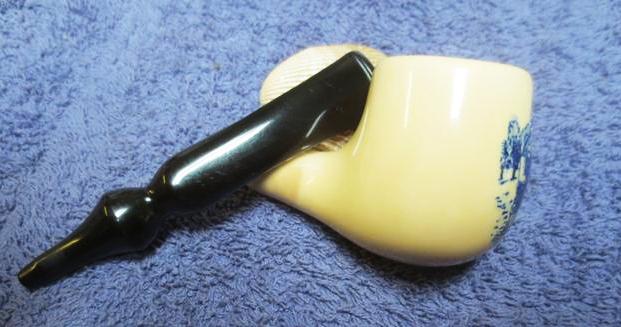
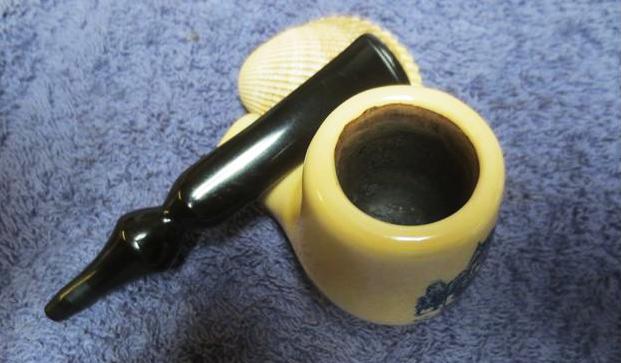
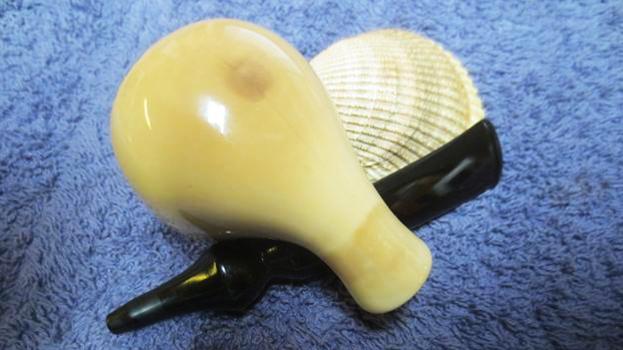
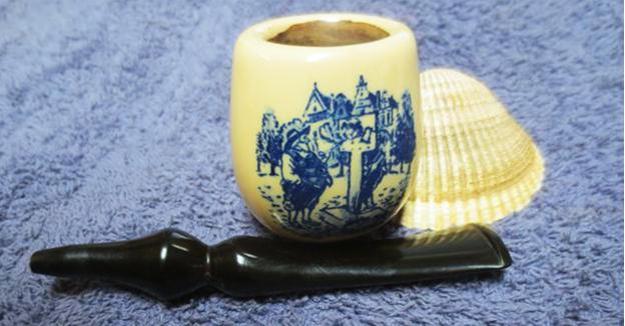
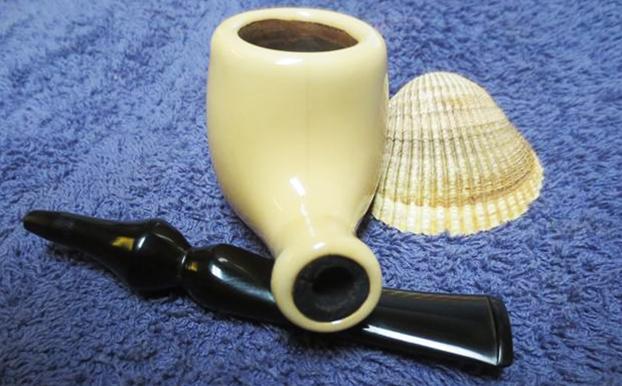 The dimensions of the larger calabash pipe are Length: 7 inches, Height: 2 ½ inches, Bowl diameter: 2 inches, Chamber diameter: 7/8 inches.I will be adding both of these pipes to the rebornpipes store shortly. I already have several of these pipes so I will be passing these on to others to try. Thanks for looking.
The dimensions of the larger calabash pipe are Length: 7 inches, Height: 2 ½ inches, Bowl diameter: 2 inches, Chamber diameter: 7/8 inches.I will be adding both of these pipes to the rebornpipes store shortly. I already have several of these pipes so I will be passing these on to others to try. Thanks for looking.